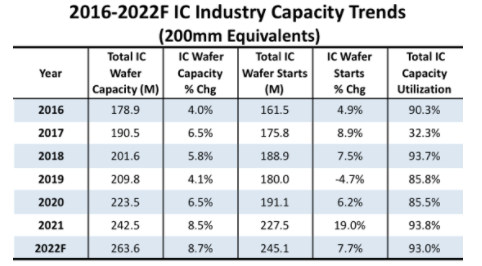
The volatility of the IC industry is reflected in the large fluctuations in the annual wafer utilization rate. Over the past five years, annual wafer starts growth has ranged from -4.7% in 2019 to 19.0% in 2021. The industry's wafer capacity also fluctuates based on market conditions, but the changes are usually not as dramatic as wafer starts. Annual growth in wafer capacity over the past five years has ranged from 4.0% in 2016 to 8.5% in 2021.
In 2021, wafer capacity increased by 8.5% and is expected to increase by 8.7% in 2022. The 8.7% increase will primarily come from the addition of 10 new 300mm fabs scheduled to open this year (up from 3 in 2021). The largest increases in capacity are forecast to come from large new memory fabs at SK Hynix and Winbond, as well as three new fabs (two in Taiwan; one in China), the world's largest pure-play foundry, TSMC. . Other new 300mm fabs include China Resources Microelectronics' power semiconductor fab; Silan Power discrete and sensor fab; TI's RFAB2 facility for analog equipment; ST/Tower's mixed-signal, power, RF and foundry factory; and SMIC's new factory for the foundry business.
Historically, the IC industry saw a net loss of wafer capacity in 2002—the first time in history that this has happened. Seven years later, in 2009, the IC industry saw an even greater net loss of wafer capacity. Total IC industry capacity declined by a record 6% in 2009 due to 29% and 40% capex cuts in 2008 and 2009, respectively, as well as a large volume of ≤200mm wafer capacity in response to severe IC production in 2008-2009 Market downturn.
The decline in wafer capacity in 2002 was partly due to a component surplus in 2000-2001. Optimism about the internet market has fueled over-ordering of chips and other electronics. When the bubble burst, more than $10 billion in excess semiconductors in the supply chain were written down or written off. In the years that followed, chip companies became very conservative about capacity.
The danger of excess is always present, but IC Insights predicts that chip demand will remain strong despite inflationary pressures, ongoing supply chain issues and other economic difficulties. Even with 10 new fabs coming online, stable unit demand is expected to help keep global capacity utilization at a high level of 93.0% in 2022, down only slightly from 93.8% in 2021.
Checks and balances have been added to the supply chain to prevent double and triple ordering. The effectiveness of these measures may be tested once the global semiconductor shortage eases.